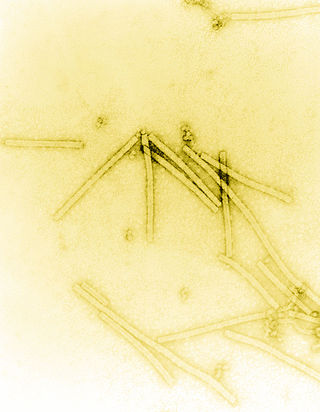
In botany, a bulb is structurally a short stem with fleshy leaves or leaf bases that function as food storage organs during dormancy.

Iris is a flowering plant genus of 310 accepted species with showy flowers. As well as being the scientific name, iris is also widely used as a common name for all Iris species, as well as some belonging to other closely related genera. A common name for some species is flags, while the plants of the subgenus Scorpiris are widely known as junos, particularly in horticulture. It is a popular garden flower.

Narcissus is a genus of predominantly spring flowering perennial plants of the amaryllis family, Amaryllidaceae. Various common names including daffodil, narcissus and jonquil, are used to describe all or some members of the genus. Narcissus has conspicuous flowers with six petal-like tepals surmounted by a cup- or trumpet-shaped corona. The flowers are generally white and yellow, with either uniform or contrasting coloured tepals and corona.

Tobacco mosaic virus (TMV) is a positive-sense single-stranded RNA virus species in the genus Tobamovirus that infects a wide range of plants, especially tobacco and other members of the family Solanaceae. The infection causes characteristic patterns, such as "mosaic"-like mottling and discoloration on the leaves. TMV was the first virus to be discovered. Although it was known from the late 19th century that a non-bacterial infectious disease was damaging tobacco crops, it was not until 1930 that the infectious agent was determined to be a virus. It is the first pathogen identified as a virus. The virus was crystallised by W.M. Stanley. It has a similar size to the largest synthetic molecule, known as PG5.

Wendell Meredith Stanley was an American biochemist, virologist and Nobel laureate.

Plant viruses are viruses that affect plants. Like all other viruses, plant viruses are obligate intracellular parasites that do not have the molecular machinery to replicate without a host. Plant viruses can be pathogenic to vascular plants.

Potyvirus is a genus of positive-strand RNA viruses in the family Potyviridae. Plants serve as natural hosts. Like begomoviruses, members of this genus may cause significant losses in agricultural, pastoral, horticultural, and ornamental crops. More than 200 species of aphids spread potyviruses, and most are from the subfamily Aphidinae. The genus contains 190 species and potyviruses account for about thirty percent of all currently known plant viruses.

Cucumber mosaic virus (CMV) is a plant pathogenic virus in the family Bromoviridae. This virus has a worldwide distribution and a very wide host range, having the reputation of the widest host range of any known plant virus. It can be transmitted from plant to plant both mechanically by sap and by aphids in a stylet-borne fashion. It can also be transmitted in seeds and by the parasitic weeds, Cuscuta sp. (dodder).

Cymbidium mosaic virus (CymMV) is a plant pathogenic virus of the family Alphaflexiviridae.
Tomato ringspot virus (ToRSV) is a plant pathogenic virus of the family Secoviridae. It affects species of cucumber, tobacco, tomato, cowpea, among others. It causes ringspots in tobacco plants and raspberries, yellow bud mosaic in peaches, yellow vein in grapes, and stunted growth in gladiolus and Narcissus. Its range is in the temperate regions of North America, especially where its vector, Xiphinema americanum is present. Along with the adult and larval stages of this nematode, the virus is also spread by seed. This type of infection is more common in strawberries and soybeans than any other susceptible plant.

Orthotospovirus is a genus of negative-strand RNA viruses, in the family Tospoviridae of the order Bunyavirales, which infects plants. Tospoviruses take their name from the species Tomato spotted wilt orthotospovirus (TSWV) which was discovered in Australia in 1919. TSWV remained the only known member of the family until the early 1990s when genetic characterisation of plant viruses became more common. There are now at least twenty species in the genus with more being discovered on a regular basis. Member viruses infect over eight hundred plant species from 82 different families.

Potexvirus is a genus of pathogenic viruses in the order Tymovirales, in the family Alphaflexiviridae. Plants serve as natural hosts. There are 48 species in this genus, three of which are assigned to a subgenus. Diseases associated with this genus include: mosaic and ringspot symptoms. The genus name comes from POTato virus X).

Carlavirus, formerly known as the "Carnation latent virus group", is a genus of viruses in the order Tymovirales, in the family Betaflexiviridae. Plants serve as natural hosts. There are 53 species in this genus. Diseases associated with this genus include: mosaic and ringspot symptoms.

Macrosiphum euphorbiae, the potato aphid, is a sap-sucking pest insect in the family Aphididae. It infests potatoes and a number of other commercially important crops.
Narcissus common latent virus (NCLV) is a plant pathogenic virus. It infects Narcissus plants. The term 'latent' refers to the fact that infection may be symptomless. Transmission occurs by Aphids.
Narcissus latent virus (NLV) is a Macluravirus, a plant pathogenic virus of the family Potyviridae, which infects Narcissus.
Narcissus degeneration virus (NDV) is a plant pathogenic Potyvirus of the family Potyviridae which infects plants of the genus Narcissus. It is one of the most serious and prevalent of the approximately 21 viruses which infect this genus.NDV is associated with chlorotic leaf striping in N. tazetta.

Iris gatesii is a species in the genus Iris, it is also in the subgenus Iris and in the section Oncocyclus. It is a rhizomatous perennial, from the mountains of Turkey and Iraq. It has long, narrow, grey-green or glaucous leaves. The strong, sturdy stem supports a single large flower in spring, between April and June. The large flowers are very variable in colouring, ranging from a pale greenish, grey, white, or creamy-yellow background colour, which is then covered with many purplish-brown, purple, or nearly black, spots, dots, short broken lines, or veining. They have a brownish purple or purple beard, over a dark signal patch. It can be cultivated as an ornamental plant in temperate regions, if it does not get too wet during summer.
Tomato mottle mosaic virus is a Tobamovirus which infects Solanum lycopersicum. First detected in Mexico in 2013 from S. lycopersicum samples taken in 2009, ToMMV has since been found throughout the world. In 2014 some S. lycopersicum samples from Florida in 2010 and 2012 and a Nicotiana tabacum 'Xanthi nc' sample were retested using an assay that distinguishes ToMMV from other Tobamoviruses, especially the closely related Tomato mosaic virus and Tobacco mosaic virus. These samples tested positive for ToMMV, showing that ToMMV was widespread and had been for several years earlier than previously known.
















